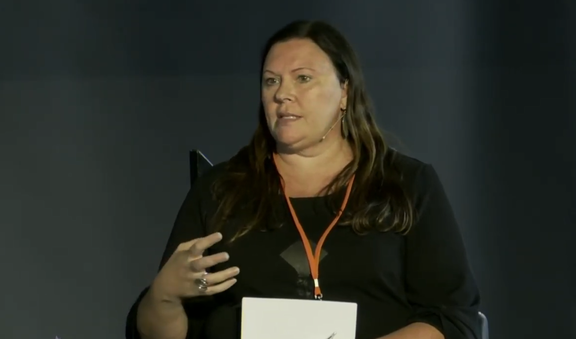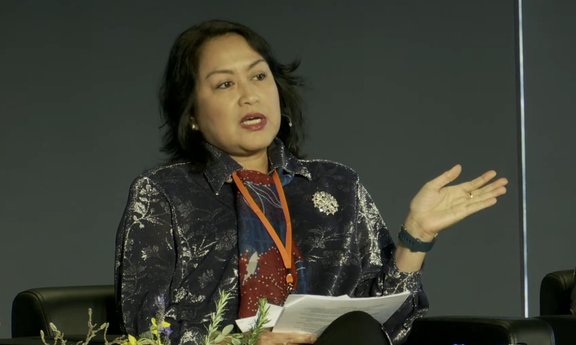MEDIAWATCH: By Colin Peacock, RNZ Mediawatch presenter
A counter-terrorism hui intended to help heal the wounds inflicted in Christchurch two years ago sparked a walk-out which hit the headlines. The news media were also there to be questioned about their rights and responsibilities after 15 March 2019.
When police National Security Adviser Cameron Bayly revealed that two possible shootings in Christchurch had been foiled in 2019 – one before and one after the atrocity on March 15 – it quickly made headline news.
The revelation came last Tuesday morning during a panel discussion at He Whenua Taurikura – an annual hui recommended by the Royal Commission of Inquiry into the terrorist attack.
He Whenua Taurikura means “a land at peace”. But the hui created rancour when an invited speaker, Jewish Council spokesperson Juliet Moses, referenced a rally in Auckland’s Queen Street in 2018 at which some had expressed support for Hezbollah.
That had not been condemned and leaders should be consistent when confronting terrorism, Moses said.
That prompted members of the Christchurch Muslim community to walk out.
One – Azad Razzaq Khan from the Foundation Against Islamophobia and Racism – said this “implied New Zealand Muslims support terrorism”.
This led news bulletins that evening and next morning – and the anger was amplified by the fact no victims or witnesses of the mosque atrocities were among speakers at the hui.
Following the startling news that a film studio wants to tell the March 15 story without consulting with victims or Muslim leaders in the city, this was a problem waiting to happen.
However, it didn’t derail He Whenua Taurikura’s second day on Wednesday, during which Islamic Women’s Council of New Zealand leader Anjum Rahman gave an eye-opening talk on online extremism after the Christchurch attacks.
Rahman, who is an adviser to the Christchurch Call and the Global Internet Forum to Counter Terrorism, showed how social media’s hyperactive algorithms still spread anti-Muslim stuff that extremists latch onto.
The He Whenua Taurikura livestream.
Media leaders face up

“Listen and respond. Do not write narratives about us without us. Do not talk over us or for us.”
— Khairiah Rahman
Leaders from New Zealand’s news media also faced questions at the hui last Tuesday.
Stuff chief executive Sinead Boucher admitted news media coverage of ethnic issues and communities is often only surface-deep and through a European lens.
But she insisted our news media have a social conscience that social media does not.
“I can think of a handful of examples in recent years where media have not published information because of the risk it could bring to someone’s safety,” Boucher told the hui.
New Zealand Herald head of premium content Miriyana Alexander said those gathered at the hui would have different ideas about how news serves the public interest.
“We are often asked not to report something, because a certain group doesn’t believe it’s in the public interest,” Alexander said.
“We are fiercely protective of that right [to report], while we acknowledge that rights carries responsibilities.”
Reporting if gunman’s crimes
A case in point was the reporting of Brenton Tarrant’s crimes back in 2019.
Stuff didn’t publish his name for a while and only minimal details of his background and apparent beliefs. The NZ Herald published a lot more about him back in March 2019.
All mainstream news media agreed on protocols for reporting his trial last year and stuck to guidelines designed to ensure he couldn’t grandstand or promote his beliefs.
“I’ve never seen that happen before in my time in media and I think it was a great credit to all organisations involved,” Alexander said.
“It was a powerful thing to do and it laid a strong foundation for the ongoing coverage and relationships.”
RNZ head of news Richard Sutherland said individual media organisations would probably have followed the same principles anyway, without a binding pact in place.
But some free speech and media freedom advocates were alarmed by that.
Media crisis meetings
Alexander – the current chair of the Media Freedom Committee which represents the mutual interests of the news media – said the media had been meeting twice a year with the Department of the Prime Minister and Cabinet (which organised this week’s hui), with terror attacks or crises in future in mind.
“Some protocols have been drafted,” said Alexander.
“I’m not aware of this happening in any other jurisdiction and it’s evidence of the media’s desire to be a responsible member of our community.”
Providing a Muslim community perspective on the panel was Khairiah A Rahman, a senior lecturer at the School of Communication Studies at Auckland University of Technology (AUT) and a board member and researcher of AUT’s Pacific Media Centre.
She analysed Representations of Islam and Muslims in New Zealand Media in 2017 and in March 2019 she told Mediawatch she had found reporting lacking in several ways.
About 13,000 of just over 14,000 stories in the New Zealand media that included the word Islam also mentioned either terrorism or Islamic Jihad — and most were from from overseas sources.
“There appears to be a growing misconceived hatred for a faith supported by 1.5 billion of the world’s population, but more importantly, this destructive trend is promoted by the media, consciously or not,” Rahman’s paper concluded.
Praised media response
Last Tuesday in Christchurch, she praised the media response to the mosque attacks, but pointed to examples of reporting from the past that had caused offence.
She cited coverage of the so-called “jihadi brides” issue.
In 2015, Prime Minister John Key called New Zealand women travelling to Syria and Iraq “jihadi brides.” The director of the Security Intelligence Service (SIS) said the numbers were rising. But in 2016, the SIS revealed none of the women involved actually left from New Zealand.
Rahman also warned visual elements of stories could be discriminatory and cited a Sunday Star Times story from 2014: Fears of terror in our own backyard.
The story was published at a time when government ministers were considering new measures to stop New Zealanders heading overseas as foreign fighters.
The main photo portrayed was of Sheik Abu Abdullah outside his home in West Auckland, under which a caption read: “FIREBRAND OR MAN OF PEACE?”
“You have to wonder what was the purpose of that,” Rahman said.
Experienced journalists
The story was written by two experienced journalists and focused on this controversial figure, also known as Abu Hamam, who had been barred from the Avondale Islamic Centre.
“He was not interviewed in the story so how is it fair to call him ‘Firebrand… or man of peace?’
“If you understand the people you’re reporting on in the marginalised position that they come from it’s not that difficult,” she said.
The story included comment from Muslims in Auckland who knew him, followers and Muslim experts. On the face of it the story has the kind of context and community input critics say is often missing.
“I disagree. If you were to run that story past the Muslim community there will be some things they will point out to you. You find that the voices are diminished, because at the end there is a list of people who have been through Australia and joined ISIS.”
At the foot of the article was a list of four “Kiwi Jihadis”, including Daryl Jones and Christopher Havard, killed in a US drone strike alongside al-Qaeda militants in 2013. The paper said Havard’s family claimed he was radicalised at a mosque in Christchurch.
“If you have a good introduction, but the final part is horrible, you go away thinking Muslim people are horrible,” Rahman said.

‘Largely negative’
Her research on how the New Zealand media treated Muslims before the Christchurch attacks showed coverage was “largely negative”.
“But in the Royal Commission’s report, there was no mention of the media having any responsibility. I made a submission to the Royal Commission pointing out that the media was responsible for perpetuating negative stereotypes and ideas – largely from international media,” Rahman said.
“I think it’s a start to recognise this.”
Rahman left the media with this message last Tuesday:
“Listen and respond. Do not write narratives about us without us. Do not talk over us or for us.”
This article is republished under a community partnership agreement with RNZ.
Article by AsiaPacificReport.nz








